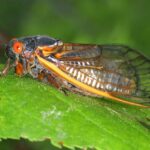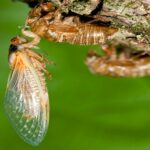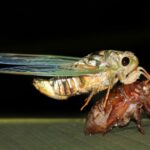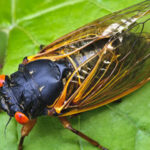 This year will mark the reemergence after 17 years of Brood X, or the Great Eastern Brood, of periodical cicadas – those large, winged, kind of scary-looking but mostly harmless flying insects known for their almost deafening buzz.
This year will mark the reemergence after 17 years of Brood X, or the Great Eastern Brood, of periodical cicadas – those large, winged, kind of scary-looking but mostly harmless flying insects known for their almost deafening buzz.
“The end of May through June, it can get pretty loud – if you are in an area where they are numerous, there can be hundreds of thousands, or millions, of them.”
One of the largest broods of periodical cicadas in the nation, Brood X will emerge this spring in 15 states: Delaware, Georgia, Illinois, Indiana, Kentucky, Maryland, Michigan, North Carolina, New Jersey, New York, Ohio, Pennsylvania, Tennessee, Virginia, West Virginia, as well as Washington, D.C.
Unlike greenish, annual cicadas, periodical cicadas are known for their black bodies and bold red eyes. Their mass, in-unison emergence every 17 years is one of nature’s great mysteries. But the bugs haven’t been in hibernation since their last mass appearance in 2004.
The cicadas live underground in wingless nymph form, about a foot or two down, feeding on sap from tree roots – “and that’s where they feed for 17 years.” Most cicadas don’t have fixed periods of development like this. When they reach adulthood, away they go, as individuals or small groups.
underground in wingless nymph form, about a foot or two down, feeding on sap from tree roots – “and that’s where they feed for 17 years.” Most cicadas don’t have fixed periods of development like this. When they reach adulthood, away they go, as individuals or small groups.
But with periodical cicadas, after 17 years underground, on just the right spring day, when soil temperatures reach 64⁰ the nymphs all together burrow their way to the surface and make their mass emergence. They climb up on the nearest thing they can find, and molt for the final time. “At that time, they are white – their exoskeleton hasn’t hardened yet. That takes five or six days. Then the adult is ready to look for a mate.”
After mating, female periodical cicadas will lay eggs in soft, new twigs, using a sharp organ called an ovipositor to cut into the branches and place her fertilized eggs inside. The solution is to put nets or bags over trees for the period of time the cicadas are active, until around the start of July.

Laid eggs hatch in 6 to 10 weeks. The tiny nymphs fall to the ground, burrowing in, and start the 17-year cycle again. Aside from being loud – their sound is a cross between a buzz and a rattle – the cicadas really won’t do any major damage. They aren’t drawn indoors. They don’t bite. While they may cause cosmetic damage to trees when laying their eggs, cicadas actually provide a number of benefits to nature.
They prune mature trees, aerate the soil, and once they die, their bodies serve as an important source of nitrogen for growing trees. In larval form, burrowed beneath the soil and feeding on fluids from plant roots.
Treatment & Solutions
Newly planted and small-diameter trees and shrubs can be protected with fine netting, cheesecloth, or row-cover fabric tied securely at the base, to keep nymphs from crawling up the trunks upon emergence, as well as preventing females from slitting bark to lay eggs.
Remove small, damaged branches to keep eggs from hatching and future populations low. Also, delay planting new trees and shrubs until adult periodical cicadas are gone, usually by mid-July.
The use of chemical sprays to kill adult periodical cicadas is not recommended. Using insecticides will also kill beneficial insects that feed on harmful insects and can injure natural predators such as birds, raccoons, skunks, and moles.
 Cicadas are edible; they’re even considered a delicacy in many countries, as well as in different parts of the United States. Some claim that cicadas are high in protein, but recent research conducted at the University of Cincinnati’s College of Engineering has determined that cicadas may contain high levels of mercury. Diners therefore are cautioned to limit their ingestion of these “delicacies” to just a few.
Cicadas are edible; they’re even considered a delicacy in many countries, as well as in different parts of the United States. Some claim that cicadas are high in protein, but recent research conducted at the University of Cincinnati’s College of Engineering has determined that cicadas may contain high levels of mercury. Diners therefore are cautioned to limit their ingestion of these “delicacies” to just a few.
If you experience an influx of insects around your home, call the experts at Universal Pest Services (610)449-0740 and schedule a free inspection today!